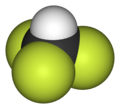| |||
| Names | |||
|---|---|---|---|
| IUPAC name Trifluoromethane | |||
| Other names | |||
| Identifiers | |||
3D model (JSmol) | |||
| Abbreviations | HFC 23, R-23, FE-13, UN 1984 | ||
| ChEBI | |||
| ChemSpider | |||
| ECHA InfoCard | 100.000.794 | ||
| EC Number |
| ||
PubChem CID | |||
| RTECS number |
| ||
| UNII | |||
CompTox Dashboard (EPA) | |||
| |||
| |||
| Properties | |||
| CHF3 | |||
| Molar mass | 70.014 g·mol−1 | ||
| Appearance | Colorless gas | ||
| Density | 2.946 kg/m3 (gas, 1 bar, 15 °C) | ||
| Melting point | −155.2 °C (−247.4 °F; 118.0 K) | ||
| Boiling point | −82.1 °C (−115.8 °F; 191.1 K) | ||
| 1 g/l | |||
| Solubility in organic solvents | Soluble | ||
| Vapor pressure | 4.38 MPa at 20 °C | ||
Henry's law constant (kH) | 0.013 mol·kg−1·bar−1 | ||
| Acidity (pKa) | 25–28 | ||
| Structure | |||
| Tetrahedral | |||
| Hazards | |||
| Occupational safety and health (OHS/OSH): | |||
Main hazards | Nervous system depression | ||
| GHS labelling: [1] | |||
 | |||
| Warning | |||
| H280 | |||
| P403 | |||
| NFPA 704 (fire diamond) | |||
| Flash point | Non-flammable | ||
| Related compounds | |||
Related compounds |
| ||
Except where otherwise noted, data are given for materials in their standard state (at 25 °C [77 °F], 100 kPa). | |||
Fluoroform, or trifluoromethane, is the chemical compound with the formula CHF3. It is a hydrofluorocarbon as well as being a part of the haloforms, a class of compounds with the formula CHX3 (X = halogen) with C3v symmetry. Fluoroform is used in diverse applications in organic synthesis. It is not an ozone depleter but is a greenhouse gas. [2]




